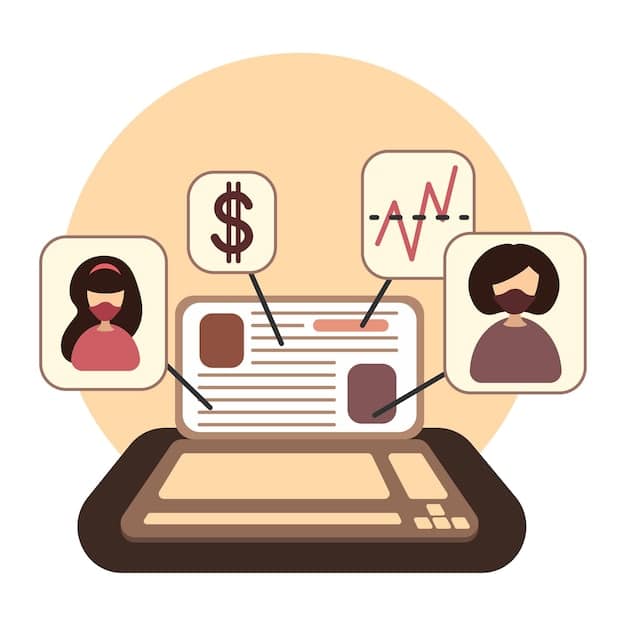Maximize Your Social Security: Decode Your Statement & Future Benefits
A Social Security statement provides an estimate of your future benefits based on your earnings history, helping you plan for retirement and understand potential income streams.
Understanding your Social Security Statement: Understanding Your Estimated Benefits and Future Projections is crucial for retirement planning. This document summarizes your earnings history and provides estimates of your future Social Security benefits, enabling you to make informed decisions about your financial future.
What is a Social Security Statement and Why Does it Matter?
A Social Security Statement is a record of your earnings history and an estimate of the future benefits you might receive. It’s issued by the Social Security Administration (SSA) and offers vital insights into your retirement planning.
Why does it matter? Because it helps you to:
Verify Your Earnings History
The statement shows your reported earnings year by year. Ensure this aligns with your records, as errors can impact your future benefits.
Estimate Retirement Income
It provides estimates for retirement benefits at different ages, helping you gauge your potential income streams.
Plan for the Future
Understanding your estimated benefits allows you to make informed decisions about savings, investments, and other retirement planning steps.

- Accuracy Check: Reviewing your earnings history for errors is crucial.
- Benefit Projections: Understand how different retirement ages impact your benefits.
- Financial Planning: Use the statement to complement your overall retirement plan.
Your Social Security Statement is a powerful tool. Regularly reviewing it empowers you to take control of your retirement readiness, ensuring a more secure future.
Accessing Your Social Security Statement: Online and Offline Options
The Social Security Administration provides multiple avenues for accessing your statement, catering to different preferences and technological access levels.
Let’s explore the options:
Online Access
The easiest way to view your statement is online through the SSA’s website. You’ll need to create a “my Social Security” account.
Creating a “my Social Security” Account
Visit the SSA website and follow the prompts to create an account. You’ll need to provide personal information to verify your identity.
Offline Access
If you’re not comfortable with online access, the SSA can mail you a physical copy of your statement. Contact the SSA to request a statement by mail.
- Online Account: Quick access and regular updates are advantages.
- Security: Protect your online account with strong passwords.
- Paper Statement: A good option for those without reliable internet access.
Whether you choose to access it online or offline, regularly reviewing your Social Security Statement is key to effective retirement planning.
Decoding Your Social Security Statement: Key Components Explained
Your Social Security Statement contains various sections. Each component provides valuable information that’s important to your retirement planning.
Let’s break down the key elements:
Personal Information
This section confirms your name, Social Security number, and date of birth. Ensure the accuracy of this information.
Earnings History
This list shows your earnings reported to the SSA each year. Verify its accuracy, as discrepancies can affect your benefits.
Estimated Benefits
This outlines estimates for retirement, disability, and survivor benefits. Note that these are only estimates.

- Accuracy is Key: Double-check every detail in the “Personal Information” section.
- Compare and Contrast: Compare your earnings history with your own records.
- Understand Projections: Keep in mind that estimated benefits are subject to change.
By understanding the different components of your Social Security Statement, you can gain a clearer picture of your potential benefits and make informed decisions about your financial future.
Understanding Estimated Benefits: Retirement, Disability, and Survivors
Your Social Security Statement provides estimates for several types of benefits, including retirement, disability, and survivors.
Let’s explore what each type of benefit means:
Retirement Benefits
This is an estimate of the monthly benefit you could receive if you retire at different ages. Full retirement age varies based on your birth year.
Disability Benefits
If you become disabled and can’t work, you may be eligible for disability benefits. The statement provides an estimate of this potential benefit.
Survivor Benefits
If you die, your surviving spouse and dependent children may be eligible for survivor benefits. The statement offers insights into these potential benefits.
These benefits can provide financial security during different life events. Consider them as you evaluate your overall financial plan.
Factors That Affect Your Social Security Benefits: Earnings, Age, and More
Several factors can impact the Social Security benefits you ultimately receive. Understanding these factors allows you to anticipate potential changes.
Consider these elements:
Earnings History
Your lifetime earnings are the primary factor in determining your benefits. Higher earnings generally result in higher benefits.
Retirement Age
The age at which you retire significantly impacts your benefits. Retiring earlier than your full retirement age reduces your benefits.
Cost-of-Living Adjustments (COLAs)
Social Security benefits are subject to annual COLAs. These adjustments reflect changes in the cost of living, helping maintain purchasing power.
By understanding factors that can impact your benefits, you can make informed decisions about your retirement timing, career trajectory, and more.
Correcting Errors on Your Social Security Statement: A Step-by-Step Guide
If you find errors on your Social Security Statement, it’s important to correct them promptly. Timely corrective actions could prevent issues in the future.
Here’s a simple guide:
Review Your Statement Carefully
Check your name, Social Security number, date of birth, and earnings history. Compare the earnings history with your W-2 forms or tax returns.
Contact the Social Security Administration
If you find errors, contact the SSA immediately. You can call them, visit a local office, or submit a written request.
Provide Supporting Documentation
Be prepared to provide supporting documentation, such as W-2 forms, tax returns, or pay stubs, to substantiate your claim.
Correcting any errors ensures that your Social Security benefits are calculated accurately.
| Key Point | Brief Description |
|---|---|
| 📝 Verify Earnings | Ensure your earnings history is accurate to maximize benefits. |
| 🗓️ Retirement Age | Understand how retirement age affects your benefit amount. |
| 🛡️ Disability & Survivor Benefits | Know the provisions for disability and survivor benefits. |
| 🌐 Access Options | Learn about online and offline access to your statement. |
Frequently Asked Questions (FAQ)
The Social Security Statement: Understanding Your Estimated Benefits and Future Projections is valuable as it offers a summary of earnings and estimates future benefits. It highlights potential benefits, guiding an informed retirement and financial planning.}
International students in the US may need a Social Security number (SSN) for employment. Social Security taxes may also be withheld from earnings, subject to tax treaty benefits.}
Begin by reviewing your personal details. Then, cross-reference reported earnings with your own records. Lastly, analyze the estimated benefits for a picture of your retirement possibilities.}
It is a good practice to review your Social Security Statement at least once a year. Regular assessments can help detect errors early, assisting in retirement planning.}
Contact the Social Security Administration immediately if you spot discrepancies. Providing supporting documents could resolve the issue quickly, ensuring accurate benefits calculations.}
Conclusion
Understanding your Social Security Statement is a critical step towards securing your financial future. By reviewing your statement regularly, correcting any errors, and understanding the factors that impact your benefits, you can make informed decisions and maximize your Social Security benefits.





